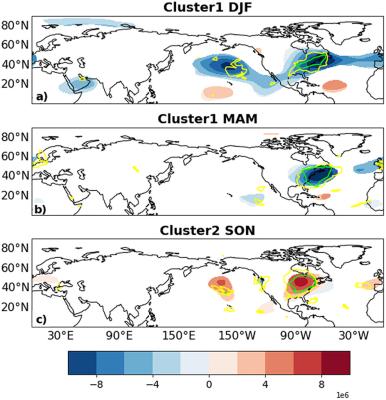Two Large-Scale Meteorological Patterns Are Associated with Short-Duration Dry Spells in the Northeastern United States
Under future climate change scenarios, certain watersheds in the northeastern United States (hereafter, the Northeast) are expected to experience more short-duration dry spells (events lasting at least a week to several weeks, but shorter than a drought timescale) due to increased warming and evaporative demand. Significant economic hardships and water supply strains could follow if these events were to become more frequent. Given the dearth of studies related to understanding the large-scale meteorology associated with short-duration dry spells and the potential risks from an increase in these types of events, the goal of this work is to fill an important knowledge gap by examining the large-scale meteorology associated with short-duration dry spells in the Northeast.
For assessing the large-scale meteorology, large-scale meteorological pattern (LSMP) analysis is implemented. LSMP analysis was previously applied to “instantaneous” fields. While time-averaged fields have been linked to LSMPs, this is the first study to apply LSMP analysis to time-averaged fields. This is also the first LSMP-based analysis of meteorological conditions associated with persistent dryness, and thus the LSMPs and large-scale meteorology described here may assist dry spell prediction and improve our understanding of the meteorological conditions that lead to reduced precipitation over the Northeast.
Two LSMPs are associated with short-duration dry spells in the Northeast. The first LSMP features a strong anomalous trough stretching from the midlatitude North American east coast across much of the mid-latitude Atlantic Ocean. The second LSMP is associated with a strong anomalous ridge over the North American continent. There is a seasonal preference for winter and spring for the first LSMP and fall for the second LSMP. Over the region, both clusters have negative specific humidity anomalies, negative integrated vapor transport from the north, and subsidence associated with a midlatitude jet stream dipole structure that reinforces upper-level convergence. Dry spells occur much less frequently during summer than in other seasons due to the limited influence of extratropical cyclones (ETCs) and the higher frequency of localized convective precipitation. ETC storm tracks are diverted away from the Northeast during the dry spells, thereby reducing precipitation from ETCs. Individual dry spells can have a mix of the larger-scale features of both cluster means, and so individual events lie on a continuum between two distinct clusters. More dry spells occur in non-drought months than in drought months, meaning that dry spells can occur without pre-existing drought conditions. Future work will examine the role of remote teleconnections in influencing the manifestation of these events. Additionally, the fidelity of CMIP6 models in capturing the properties of these short-duration dry spell events will be examined.

